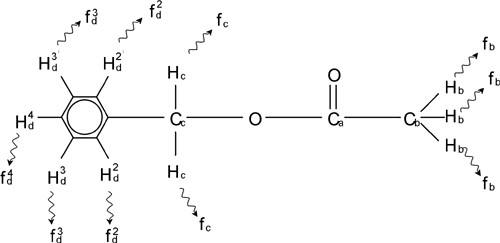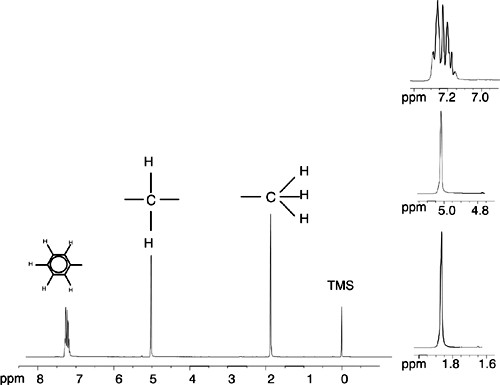Proton Spectrum of Benzylacetate
Benzylacetate (C6H5 - CH2 - O - CO - CH3) is a more complicated organic molecule whose structure is illustrated in the following figure:
Benzylacetate
We can now distinguish between three different groups of protons that have been labeled accordingly. For example, the three protons labeled Hb clearly find themselves in a different atomic environment to that of the two protons labeled Hc.
The three Hb protons are bonded to the carbon Cb which is single-bonded to another carbon atom Ca. The two Hc protons are bonded to the carbon Cc which itself is single-bonded to the benzene ring and an oxygen atom. The third group of protons consists of the five protons Hd of the benzene ring itself. The figure above is a proton spectrum of benzylacetate in acetone - d6. In this spectrum we expect three signals corresponding to the three groups of protons.
Note that the position of signals from the benzene ring protons has been shifted slightly from 7.5 ppm (shown in the Spectrum of Benzene figure) to approximately 7.2 ppm (shown in the figure below).
The benzene ring protons are no longer magnetically equivalent, are to some extent not even chemically equivalent, and have been labeled accordingly. It is clear from figure 3.10 that the signal arising from the Hd protons is a multiplet, but such details will be omitted until the next section. The three proton peaks shown in this figure have clearly different intensities.
Quantitative analysis of the spectrum is relatively simple, since all the signals are emitted by the same 1H isotope i.e. natural abundance and inherent sensitivity to the NMR technique is the same for each peak. Therefore the area under the benzene, CH2 and CH3 peaks should be in the ratio of 5:2:3 respectively corresponding to the contributing number of protons.
Proton Spectrum of Benzylacetate



